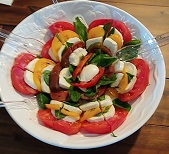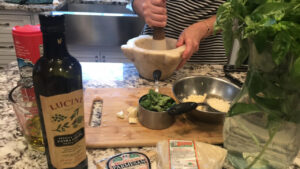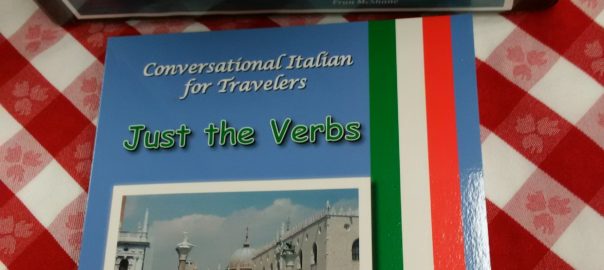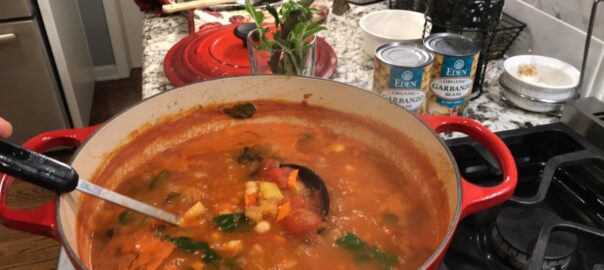Lentil Soup brings a Buon Anno Nuovo!
Lentil Soup brings a Buon Anno Nuovo! Called Zuppa di Lenticchie in Italian, it brings a Happy New Year!
Lentil Soup brings a Buon Anno Nuovo!
Lentil Soup brings a Buon Anno Nuovo! is a partial reprint from a blog originally posted on February 16, 2016, titled: “Italian Recipe: Lentil Soup (Zuppa di Lenticchie).”
In this updated version, I’ve added a note about what type of pasta is traditionally used for this soup and how to chop the vegetables so they are small enough and uniform shape to cook through evenly.
Also…
I’ve since added Instagram to my social media, and have added a video from Instagram to this post so you can see me cooking in real-time! I hope you like it!
For more recipes like these, as well as French recipes, follow me on my Instagram posts at Conversationalitalian.french.
View this post on Instagram
And now… the original story!
Lentil soup is said to bring to luck to the family on New Year’s Day. I am not sure if anyone really knows exactly why lentils are supposed to be good luck. Maybe it is because they are shaped like small coins?
Whatever the reason lentils are a preferred dish for the new year, lentils are loved by Italians year round, and make a wonderful, hot, nourishing soup for everyone. Try this recipe, and I think you will agree, even if you’ve never eaten lentils before. Any kind of miniature pasta can be used in this soup. My mother usually breaks regular spaghetti into shorter pieces for her version, although miniature ravioli are fun if you can find them in your local grocery store. For a vegetarian dish, dried ravioli with squash filling, which are pictured in this blog, are a wonderful complement to the lentils.
Warm wishes for a Buon Anno 2022 a tutti!
—Kathryn Occhipinti

Ingredients
3 Tablespoons olive oil
1 onion (chopped finely)
2 carrots (chopped finely)
1 stick of celery (chopped finely)
1 package (12 oz.) dried lentils (sorted and rinsed once but not soaked)
1 tsp crushed, dried sage
1 bay leaf
optional: meat stock or broth*
1 can (14.5 oz.) chopped tomatoes
about 6 oz. capellini pasta or dried miniature squash ravioli**
Use a large, wide-bottom pot to make this soup.
Heat the olive oil over medium heat and then add the chopped onion, celery, and carrot and cook, stirring, until both have softened a bit.
Add the lentils and cook the vegetables a bit longer, stirring, but do not let the onions brown. (This initial cooking of the lentils is said to harden the skin, so they will not become too mushy. If you like more mushy lentils, skip the sauté and just add the lentils after the rest of the vegetables have become soft . This will also decrease the overall cooking time.)
Add enough water (or meat stock if you have it and do not want a vegetarian dish) to cover the vegetables—about 6–8 cups—the dried sage, and the bay leaf.
Cover and bring to a boil; uncover, reduce heat, and simmer 45 minutes.
After the vegetables have cooked a bit, taste the soup. See how much the lentils have softened, and if they are still hard, cook longer. If they are about soft enough for your liking, proceed as follows:
Add about 1 Tablespoon of salt (to taste; less can be used) and an additional 2–4 cups of water for the pasta that you will soon be adding. Cover and bring soup back to a rolling boil.
When the soup is at a rolling boil, add the chopped tomatoes and the tomato juice from the can and the pasta. Dried, miniature ravioli with squash filling were used for this blog originally, as pictured above the recipe. Traditional pasta for this dish is capellini pasta, cut into short pieces, as shown in the Instagram video. Any small pasta will do, though, such as ditalini pasta or even miniature ravioli or tortellini.
Cook until the pasta is “al dente” or “to the tooth.”
Remember to remove the bay leaf before serving!
Enjoy with crusty Italian bread on a cold winter’s day!
*Italian “meat stock or broth” is often composed of whatever bones and small pieces of meat are left over from the night before—chicken and pork bones can be combined, for instance, or just one or the other used. When I make this soup for my family, it is usually with pork chop bones and meat left over from Monday night’s dinner. Adding homemade meat broth gives the soup a nice added complexity.
**The dried ravioli used for the dish pictured was the “La Piana” brand imported from Italy, “ravioli with squash filling,” which also adds a nice bit of flavor to the dish. Here are some links to help you find this pasta in the United States: Italian Foods Corporation, La Piana Italian foods Facebook page, Pennsylvania Macaroni Food Company.
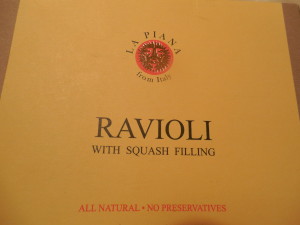
How to Chop Vegetables
Carrots: Cut lengthwise to half, and then lengthwise again to get quarters. Line them up side by side and then cut crosswise from the tips to the base of the carrot to get small, even pieces that look like quarters of a circle.
Celery: Cut lengthwise through each celery stalk as many times as needed to give pieces the same thickness as the carrot pieces. (You will need more lengthwise cuts at the thicker part of the celery near the base.) Then cut crosswise from the tip to the base to get small, rectangular pieces of celery about the same size as the carrot pieces.
Onions: Cut lengthwise through the onion. Turn one of the halves flat side down. Holding the onion together with one hand, cut lengthwise along the green lines through the onion, except for the root holding the onion together at the base. Turn and cut horizontally, from the side away from the stem toward the stem. Just before reaching the stem, flip the onion flat again and make the final cuts. Discard the piece that contains the stem.
—Kathryn Occhipinti

Available on amazon.com and Learn Travel Italian.com
Kathryn Occhipinti, MD, is the author of the
Conversational Italian for Travelers series of books and a teacher of Italian for travelers to Italy in the Peoria and Chicago area.
“Everything you need to know to enjoy your visit to Italy!”
Join my Conversational Italian! Facebook group and follow me on Twitter at StellaLucente@travelitalian1 and start to learn Italian today for FREE!
Conversational Italian! Facebook Group
Tweet @travelitalian1 for Stella Lucente Italian
YouTube videos to learn Italian are available from © Stella Lucente, LLC.
Learn Conversational Italian.
More information on and photographs of Italy can be found on Facebook Stella Lucente Italian and Pinterest Stella Lucente Italian.
Facebook Stella Lucente Italian
Pinterest Stella Lucente Italian
Visit learntravelitalian.com/download.html to purchase/download Conversational Italian for Travelers and find more interesting facts and helpful hints about getting around Italy! Learn how to buy train tickets online, how to make international and local telephone calls, and how to decipher Italian coffee names and restaurant menus, all while gaining the basic understanding of Italian that you will need to know to communicate easily and effectively while in Italy. —From the staff at Stella Lucente, LLC
Lentil Soup Brings a Buon Anno Nuovo!





